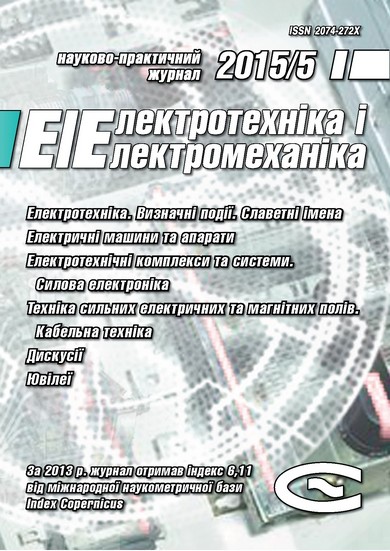COMPARATIVE ANALYSIS OF ACTIVE POWER LOSSES OF INDUCTION MOTORS WITH CYLINDRICAL AND AXIAL AIR GAPS
DOI:
https://doi.org/10.20998/2074-272X.2015.5.04Keywords:
losses indication, optimum geometric dimensions, traditional and axial field motorsAbstract
Purpose. To find the analytical expressions of determining the optimum geometric dimensions by criteria of the losses minimum of axial field squirrel-cage induction motors and to compare traditional and axial field motors. Methodology. We have applied the method of the relative indications of the technical level with relative controlled variables. We have used the approximation of the experimental dependence of the distribution of the induction in the air gap and the integral averaging of the magnetic flux. Results. We have developed the mathematical model for determining the optimum geometric dimensions by criteria of the losses minimum of the active part of axial field squirrel-cage induction motors taking into account the radial distribution of the induction in the air gap and teeth. We have considered the comparative analysis of the indications of active power losses of traditional and axial designs of electromagnetic equivalent motors. Originality. For the first time we have created the mathematical model of the active power losses of the active part of axial field squirrel-cage induction motors with the uneven distribution of the magnetic flux in the core and investigated the effect of the geometric relationships on the energy efficiency of axial field motors. Practical value. Based on the superior parametric compatibility and the high energy efficiency of axial motors the expediency of replacing traditional induction motors to axial field induction motors has been proved in the special drives, which operates in continuous duty. Also obtained by simulation optimal geometric relationships of the magnetic circuit can be used in the manufacture and design of axial motors by criteria of the losses minimum.References
Stavinskii A.A. Problem and directions of further evolution of electromechanical devices. Elektrotekhnіka і elektromekhanіka – Electrical engineering & electromechanics, 2004, no.1, pp. 57-61. (Rus).
Kazanskii V.M., Zonov V.N., Britanchuk V.M. To the question about the comparison of axial and cylindrical low-power versions of induction motors. Materialy mezhvuzovskoi nauchno-tekhnicheskoi konferentsii «Asinkhronnye mikromashiny». [Abstracts of Int. Sci.-Pract. Conf. «Induction micromachines»]. Kaunas, 1969, pp. 216-219. (Rus).
Ignatov V.Ya., Vil'danov K.Ya. Tortsevye asinkhronnye elektrodvigateli integral'nogo izgotovleniia [Axial field induction integrated manufacturing motors]. Moscow, Energoatomizdat Publ., 1988. 304 p. (Rus).
Stavinskii A.A., Gidulian V.I. Germetichnyi kholodil'nyi kompressor [Hermetic refrigeration compressor]. Inventor's certificate USSR, no.2758809, 1979. (Rus).
Stavinskii A.A. Improving marine counter rotating electromechanical systems based on specific induction motors. Sudostroenie – Shipbuilding, 2011, no.6, pp. 35-38. (Rus).
Caricchi F. Axial flux electromagnetic differential induction motor. 17th Int. Conf. on Electrical Machines and Drives. Institution of Engineering and Technology (IET), 11-13 Sept. 1995, pp. 1-5. doi: 10.1049/cp:19950824.
Igelspacher J., Herzog H.-G. Analytical description of a single-stator axial-flux induction machine with squirrel cage. XIX Int. Conf. on Electrical Machines (ICEM 2010). Institute of Electrical & Electronics Engineers (IEEE), 6-8 Sept. 2010, pp. 1-6. doi: 10.1109/icelmach.2010.5608227.
Profumo F., Zheng Zhang, Tenconi A. Axial flux machines drives: a new viable solution for electric cars. IEEE Transactions on Industrial Electronics, 1997, vol.44, no.1, pp. 39-45. doi: 10.1109/41.557497.
Available at: http://www.axcomotors.com/axial-flux_technology.html (accessed 11 May 2014).
Dombrovskii V.V., Zaichik V.M. Asinkhronnye mashiny: teoriia, raschet, elementy proektirovaniia [Asynchronous machines: theory, calculation, design elements]. Leningrad, Energoatomizdat. Publ., 1990. 368 p. (Rus).
Stavinskii A.A., Palchykov O.O. Comparative analysis of weight and cost indications of induction motors with cylindrical and axial air gaps. Elektrotekhnіka і elektromekhanіka – Electrical engineering & electromechanics, 2015, no.3, pp. 20-26. (Rus).
Stavinskii A.A., Palchykov O.O. Application of a relative technical level index method to induction motor optimization problems. Elektrotekhnіka і elektromekhanіka – Electrical engineering & electromechanics, 2014, no.5, pp. 37-44. (Rus).
Stavinskii A.A., Palchykov O.O. Objective functions of the comparative analysis of the energy efficiency of electromagnetic systems of induction motors with inner and outer rotors. Elektrotekhnіka і elektromekhanіka – Electrical engineering & electromechanics, 2015, no.1, pp. 41-45. (Rus).
Stavinskii A.A., Stavinskii R.A., Avdeeva E.A. Optimization comparative analysis of static electromagnetic systems structures. Part. 1. Options and method of assessment of change. Elektrichestvo – Electricity, 2014, no.9, pp. 34-43. (Rus).
Downloads
Published
How to Cite
Issue
Section
License
Copyright (c) 2015 A. A. Stavinskii, O. O. Palchykov

This work is licensed under a Creative Commons Attribution-NonCommercial 4.0 International License.
Authors who publish with this journal agree to the following terms:
1. Authors retain copyright and grant the journal right of first publication with the work simultaneously licensed under a Creative Commons Attribution License that allows others to share the work with an acknowledgement of the work's authorship and initial publication in this journal.
2. Authors are able to enter into separate, additional contractual arrangements for the non-exclusive distribution of the journal's published version of the work (e.g., post it to an institutional repository or publish it in a book), with an acknowledgement of its initial publication in this journal.
3. Authors are permitted and encouraged to post their work online (e.g., in institutional repositories or on their website) prior to and during the submission process, as it can lead to productive exchanges, as well as earlier and greater citation of published work.





